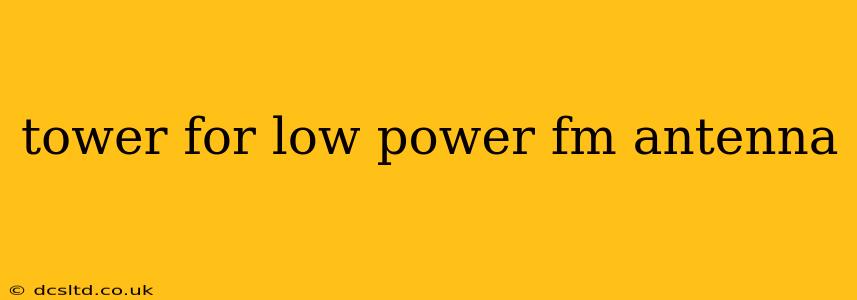Choosing the right tower for your low-power FM antenna is crucial for optimal broadcast range and signal quality. This decision depends on several factors, and understanding these nuances will ensure your station reaches its intended audience effectively. This guide will explore the key considerations for selecting the appropriate tower, addressing common questions and concerns.
What are the Different Types of Towers for FM Antennas?
Several tower types can support low-power FM antennas. The best choice depends on factors like budget, location, and desired broadcast range. Common options include:
-
Self-Supporting Towers: These freestanding structures are typically made of galvanized steel and are designed to withstand wind loads without guy wires. They're ideal for locations where guy wires are impractical or prohibited. They offer a clean aesthetic but often come with a higher price tag.
-
Guyed Towers: These towers rely on guy wires for stability and support. They are generally more cost-effective than self-supporting towers, especially for taller structures. However, the guy wires require additional ground space and careful consideration of potential obstructions.
-
Rooftop Mounts: For low-power FM stations with limited space, mounting the antenna on an existing building's rooftop can be a viable option. This minimizes the need for a separate tower and can be a cost-effective solution. However, rooftop mounts might restrict antenna height and potentially impact signal coverage.
What Height Tower Do I Need for My Low Power FM Antenna?
The optimal tower height is determined by several factors, including:
-
Desired Coverage Area: Taller towers generally provide greater broadcast range. However, the actual coverage depends on factors such as terrain, obstacles, and antenna design.
-
Regulatory Requirements: The FCC (in the US) and other regulatory bodies impose limitations on antenna height and power output. You must comply with all applicable regulations to ensure legal operation.
-
Local Obstructions: Trees, buildings, and hills can significantly impact signal propagation. A site survey is essential to assess these factors and determine the most effective tower height.
-
Budgetary Constraints: Taller towers typically cost more to purchase and install.
How Much Does a Tower for a Low Power FM Antenna Cost?
The cost of a tower varies widely based on:
-
Tower Height: Taller towers naturally cost more.
-
Tower Type: Self-supporting towers generally cost more than guyed towers.
-
Materials: The type of steel and construction quality will impact the price.
-
Installation Costs: Labor costs can be substantial, especially for taller towers.
-
Additional Features: Features like lightning protection systems or antenna mounting brackets will add to the overall cost. Getting multiple quotes from reputable tower installers is recommended to get a fair price.
What is the Best Material for a Low Power FM Antenna Tower?
Galvanized steel is the most common material used for FM broadcast towers due to its strength, durability, and resistance to corrosion. Aluminum is sometimes used for lighter structures, but it's generally less common for FM broadcast towers due to its lower strength.
What are the Safety Considerations When Installing a Tower for My Low Power FM Antenna?
Safety is paramount when installing a broadcast tower. Always ensure:
-
Professional Installation: Engaging experienced tower installers is crucial to ensure proper grounding, anchoring, and structural integrity. Improper installation can lead to safety hazards and signal issues.
-
Regular Maintenance: Regular inspections and maintenance are essential to identify and address any potential problems before they become safety hazards.
-
Compliance with Safety Regulations: Adhere to all relevant safety standards and building codes during installation and operation.
-
Warning Lights and Signage: Depending on height and location, warning lights and signage might be required to prevent aircraft collisions.
This guide provides a starting point for selecting the right tower for your low-power FM antenna. Remember to consult with licensed professionals and adhere to all applicable regulations for a safe and successful broadcast operation. Thorough planning, site surveying, and professional installation are essential for optimizing your station's reach and signal quality while ensuring compliance and safety.
